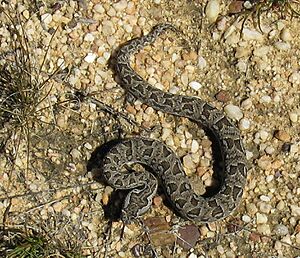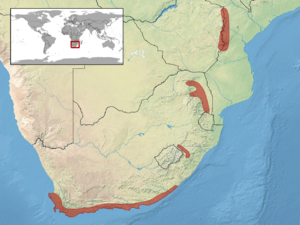Berg adder facts for kids
Quick facts for kids Berg adder |
|
|---|---|
 |
|
| A Berg Adder in the Cederberg mountains. Its colors help it blend in! | |
| Conservation status | |
| Scientific classification | |
| Genus: |
Bitis
|
| Species: |
atropos
|
 |
|
The berg adder (Bitis atropos) is a type of venomous viper that lives only in the mountains of southern Africa. It's known for its unique venom and how it blends into its rocky home.
Contents
About the Berg Adder
The berg adder gets its scientific name, atropos, from an ancient Greek goddess named Atropos. She was one of the Three Fates who, in myths, would cut the thread of life. This name hints at the snake's venomous nature.
People also call this snake by other names, like the Cape mountain adder or simply the mountain adder.
What Does the Berg Adder Look Like?
Most adult berg adders are about 30 to 40 centimeters (around 12 to 16 inches) long. That's about the length of a school ruler! Some female snakes can grow a bit bigger, reaching up to 50 centimeters (20 inches) in the wild. In special care, some have even grown to 60 centimeters (24 inches).
Where Do Berg Adders Live?
You can find berg adders in specific mountain areas across southern Africa. They live in different parts of South Africa, including the Drakensberg mountains and the Cape Province. They are also found in countries like Eswatini, Lesotho, and in the high mountains of Zimbabwe and nearby Mozambique.
Berg Adder Habitats
Berg adders like places that are cool and get a lot of rain. In the northern parts of their home range, where winters are cold and dry, they stick to very high places, sometimes up to 3,000 meters (about 9,800 feet) high. In Zimbabwe, you won't find them below 1,500 meters (about 4,900 feet). They often live on mountain slopes and rocky hillsides.
In the southern parts of their range, like the Cape Province in South Africa, winters are cold and wet. Here, berg adders can live in coastal areas, mountain heathlands, and even near sea level in rocky spots or grassy areas with bushes.
What Do Berg Adders Eat?
The berg adder is special among its snake relatives because its venom mainly affects the nervous system. This means that if someone is bitten, they usually won't have severe tissue damage or infections.
These snakes are known to be a bit "grumpy." If you bother them, they might hiss loudly and twist around a lot.
Berg Adder Venom and Its Effects
The berg adder's venom is mostly neurotoxic. This type of venom helps them catch their favorite foods, which are mostly rock lizards and small amphibians like frogs. They also eat small rodents and young birds that nest on the ground.
While their venom is strong enough for their prey, it's usually not enough to kill an adult human. There are no known cases of people dying from a berg adder bite. However, the bite can still be serious and needs medical attention. The effects of the venom can appear quickly.
Unlike some other venomous snakes, the berg adder's bite doesn't seem to cause big problems with the heart or breathing. But the effects can be annoying and might last for days or even weeks. This suggests the venom can cause nerve damage that takes time to heal. Some symptoms might include losing your sense of smell or taste, droopy eyelids, or blurry vision.
Reproduction and Life Cycle
Berg adders give birth to live young, which is called being viviparous. The baby snakes are usually born in late summer. A mother berg adder typically has about seven babies at a time, but she can have as many as 15! When they are born, each baby snake is about 13 centimeters (5 inches) long, including its tail.


